Eel life history
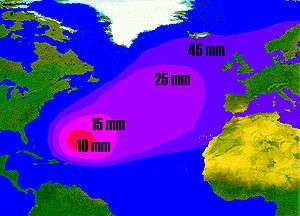
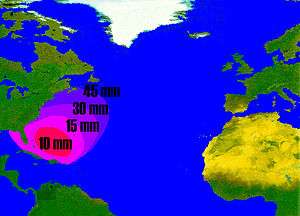
The eel is a long, thin bony fish of the order Anguilliformes. Because fishermen never caught anything they recognized as young eels, the life cycle of the eel was a mystery for a very long period of scientific history. Although more than 6500 publications mention eels, much of their life history remains an enigma.
The European eel (Anguilla anguilla) was historically the one most familiar to Western scientists, beginning with Aristotle, who wrote the earliest known inquiry into the natural history of eels. He speculated that they were born of "earth worms", which he believed were formed of mud, growing from the "guts of wet soil" rather than through sexual reproduction. Many centuries passed before scientists were able to demonstrate that such spontaneous generation does not occur in nature.
Other early scientists believed that the eelpout Zoarces viviparus was the "mother of eels" (the translation of the German name "Aalmutter").
Past studies of eels
In 1777, the Italian Carlo Mondini located an eel's gonads and demonstrated that eels are a kind of fish. In 1876, as a young student in Austria, Sigmund Freud dissected hundreds of eels in search of the male sex organs. He had to concede failure in his first major published research paper, and turned to other issues in frustration.[1][2][3][4]
Larval eels — transparent, leaflike two-inch (five-cm) creatures of the open ocean — were not generally recognized as such until 1893; instead, they were thought to be a separate species, Leptocephalus brevirostris (from the Greek leptocephalus meaning "thin- or flat-head"). In 1886, however, the French zoologist Yves Delage discovered the truth when he kept leptocephali alive in a laboratory tank in Roscoff until they matured into eels, and in 1896 Italian zoologist Giovanni Battista Grassi confirmed the finding when he observed the transformation of a Leptocephalus into a round glass eel in the Mediterranean Sea. (He also observed that salt water was necessary to support the maturation process.) Although the connection between larval eels and adult eels is now well understood, the name leptocephalus is still used for larval eel.
Search for the spawning grounds

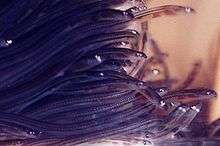
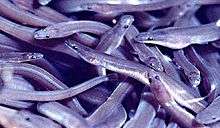
European eel
The Danish professor Johannes Schmidt, beginning in 1904, led a series of expeditions into the Mediterranean Sea and the North Atlantic to investigate eels. The expeditions were largely financed by the Carlsberg Foundation. He noted that all the leptocephali he found were very similar, and hypothesized that they all must have descended from a common ancestor species. He also observed that the farther out to sea in the Atlantic Ocean he went, the smaller the leptocephali he caught were. In a 1922 expedition, he sailed as far as the Sargasso Sea, south of Bermuda, where he caught the smallest eel-larvae that had ever been seen.
Although Schmidt did not directly observe eel spawning, or even find ready-to-spawn adult eels, he was able to deduce the following about the life history of the eel, based on the size distribution of the leptocephali he collected:
The larvae of European eels travel with the Gulf Stream across the Atlantic Ocean, and grow to 75–90 mm within one to three years, before they reach the coasts of Europe. Eels in this so-called "recruitment" developmental stage are known as glass eels because of the transparency of their bodies. Glass eels typically refers to an intermediary stage in the eel's complex life history between the leptocephalus stage and the juvenile (elver) stage. Glass eels are defined as "all developmental stages from completion of leptocephalus metamorphosis until full pigmentation".[5] The term typically refers to a transparent glass eel of the family Anguillidae.
One well-known location in which the large-scale collection of glass eels takes place (for deli food and stocking) is Epney, on the Severn, in England. (Glass eels are a food item in Spain.) Once they recruit to coastal areas, they migrate up rivers and streams, overcoming various natural challenges — sometimes by piling up their bodies by the tens of thousands to climb over obstacles — and they reach even the smallest of creeks. These freshwater eels spawn in the ocean, and then enter estuaries as glass eels and swim upstream to live in fresh water during their juvenile growth phase. As the glass eels enter fresh waters, they start to become pigmented and are typically referred to as elvers. The elvers grow larger and are referred to as yellow eels, which are the juvenile stage of eels before their reproductive maturation begins.
They can propel themselves over wet grass and dig through wet sand to reach upstream headwaters and ponds, thus colonising the continent. In fresh water, they develop pigmentation, turn into elvers (young eels), and feed on creatures such as small crustaceans, worms, and insects. After 10 to 14 years, they have matured and grown to a length of 60 to 80 cm. At this stage, they are called yellow eels because of their golden pigmentation. Marine eels of the order Anguilliformes also have a leptocephalus stage, and likely pass through a stage similar to the anguillid glass eels, but they are rarely seen in the ocean.
In July, some individuals mature and migrate back towards the sea, crossing wet grasslands at night to reach rivers that lead to the sea. Eel migration out of their freshwater growth habitats from various parts of Europe, or through the Baltic Sea in the Danish belts, have been the basis of traditional fisheries with characteristic trapnets.
How the adults make the 6,000 km (3,700 mi) open ocean journey back to their spawning grounds north of the Antilles, Haiti, and Puerto Rico remains unknown. By the time they leave the continent, their gut dissolves, making feeding impossible, so they have to rely on stored energy alone.[6] The external features undergo other dramatic changes, as well: the eyes start to enlarge, the eye pigments change for optimal vision in dim blue clear ocean light, and the sides of their bodies turn silvery, to create a countershading pattern which makes them difficult to see by predators during their long, open-ocean migration. These migrating eels are typically called "silver eels" or "big eyes".
The German fisheries biologist Friedrich Wilhelm Tesch, an eel expert and author of the book The Eel (ISBN 0-632-06389-0), conducted many expeditions with high-tech instrumentation to follow eel migration, first down the Baltic, then along the coasts of Norway and England, but finally the transmitter signals were lost at the continental shelf when the batteries ran out. According to Schmidt, a travel speed in the ocean of 15 km per day can be assumed, so a silver eel would need 140 to 150 days to reach the Sargasso Sea from around Scotland and in about 165 to 175 when leaving from the English Channel.
Tesch — like Schmidt — kept trying to persuade sponsors to provide more funding for expeditions. His proposal was to release 50 silver eels from Danish waters, with transmitters that would detach from the eels each second day, float up toward the surface, and broadcast their position, depth, and temperature to satellite receivers. He also suggested that countries on the western side of the Atlantic could perform a similar release experiment at the same time. However, even today, only preliminary experiments along these lines have ever been performed. Migration was mapped in 2016.[7]
Knowledge of what happens to individual silver eels after they leave the continental shelf is based solely on the study of three eels found in the stomachs of deepsea fishes and whales — caught off the coasts of Ireland and the Azores — and on laboratory research into the physiology of eels.
American eel
Another Atlantic eel species is known: the American eel, Anguilla rostrata. First it was believed European and American eels were the same species due to their similar appearance and behavior, but they differ in chromosome count and various molecular genetic markers, and in the number of vertebrae, A. anguilla counting 110 to 119 and A. rostrata 103 to 110.
The spawning grounds for the two species are in an overlapping area of the southern Sargasso Sea, with A. rostrata apparently being more westward than A. anguilla, and with some spawning by the American eel possibly even occurring off the Yucatán Peninsula off the Gulf of Mexico, but this has not been confirmed. After spawning in the Sargasso Sea and moving to the west, the leptocephali of the American eel exit the Gulf Stream earlier than the European eel and begin migrating into the estuaries along the east coast of North America between February and late April at an age around one year and a length around 60 mm.
Japanese eel
The spawning area of the Japanese eel, Anguilla japonica, has also been precisely located to be to the west of the Suruga seamount[8] and their leptocephali are then transported to the west to East Asia by the North Equatorial Current. Furthermore, in June and August 2008, Japanese scientists discovered and caught matured adult eels of A. japonica and A. marmorata in the West Mariana Ridge.[9]
Southern Africa's four species of freshwater eels (A. mossambica, A. bicolor bicolor, A. bengalensis labiata, and A. marmorata) have a very interesting migratory pattern. It takes them on a long journey from their spawning grounds in the Indian Ocean north of Madagascar to high up in some of the Southern African river systems and then back again to the ocean off Madagascar.[10]
Decline of the glass eels
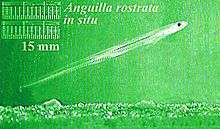

No one yet knows the reasons, but beginning in the mid-1980s, glass eel arrival in the spring dropped drastically — in Germany to 10% and in France to 14% of their previous levels — from even conservative estimates. Data from Maine and other North American coasts showed similar declines, although not as drastic.
In 1997, European demand for eels could not be met for the first time ever, and dealers from Asia bought all they could. The traditional European stocking programs could not compete any longer: each week, the price for a kilogram of glass eel went up another US$30. Even before the 1997 generation hit the coasts of Europe, dealers from China alone placed advance orders for more than 250,000 kg, some bidding more than $1,100 per kg. Asian elvers have sold in Hong Kong for as much as $5,000 to $6,000 a kilogram at times when $1,000 would buy the same amount of American glass eels at their catching sites.[11] Such a kilogram, consisting of 5000 glass eels, may bring at least $60,000 and as much as $150,000 after they leave an Asian fish farm. In New Jersey, over 2000 licences for glass eel catch were issued and reports of 38 kg per night and fisherman have been made, although the average catch is closer to 1 kg.
The demand for adult eels has continued to grow, as of 2003. Germany imported more than $50 million worth of eels in 2002. In Europe, 25 million kg are consumed each year, but in Japan alone, more than 100 million kg were consumed in 1996. As the European eels become less available, worldwide interest in American eels has increased dramatically.
New high-tech eel aquaculture plants are appearing in Asia, with detrimental effects on the native Japanese eel, A. japonica. Traditional eel aquaculture operations rely on wild-caught elvers, but experimental hormone treatments in Japan have led to artificially spawned eels. Eggs from these treated eels have a diameter of about 1 mm, and each female can produce 2 to 10 million eggs.
Threats to eels
Strong concerns exist that the European eel population might be devastated by a new threat: Anguillicola crassus, a foreign parasitic nematode. This parasite from East Asia (the original host is A. japonica) appeared in European eel populations in the early 1980s. Since 1995, it also appeared in the United States (Texas and South Carolina), most likely due to uncontrolled aquaculture eel shipments. In Europe, eel populations are already from 30% to 100% infected with the nematode. Recently, this parasite was shown to inhibit the function of the swimbladder as a hydrostatic organ.[12] As open ocean voyagers, eels need the carrying capacity of the swimbladder (which makes up 3–6% of the eel's body weight) to cross the ocean on stored energy alone.
Because the eels are catadromous (living in fresh water but spawning in the sea), dams and other river obstructions can block their ability to reach inland feeding grounds. Since the 1970s, an increasing number of eel ladders have been constructed in North America and Europe to help the fish bypass obstructions.
In New Jersey, an ongoing project monitors the glass eel migration with an online in situ microscope. As soon as more funding becomes available, it will be possible to log in to the system via a Longterm Ecological Observatory (LEO) site.
See also
References
- ↑ Freud, Sigmund, "Beobachtungen über Gestaltung und feineren Bau der als Hoden beschriebenen Lappenorgane des Aals" ["Observations on the configuration and finer structure of the lobed organs in eels described as testes"], Sitzungsberichte der Kaiserlichen Akademie der Wissenschaften. Mathematisch-Naturwissenschaftliche Classe, Vol. 75, p. 419 (1877). Freud's study was in response to Szymon Syrski's book Ueber die Reproductions-Organe der Aale (1874); see Ursula Reidel-Schrewe "Freud's Début in the Sciences" in: Sander L. Gilman, Jutta Birmele, Jay Geller, Valerie D Greenberg (eds.), Reading Freud's Reading, NYU Press, 1995, pp. 1–22.
- ↑ "Was dachten Nazis über den Aal? | Archiv - Berliner Zeitung" (in German). Berlinonline.de. 2004-10-20. Retrieved 2013-07-16.
- ↑ FH. "Der Aal im Nationalsozialismus". Wno.org. Archived from the original on December 17, 2011. Retrieved 2012-01-04.
- ↑ "Sigmund Freud und der Aal" (in German). Kulturkurier.de. Retrieved 2013-07-16.
- ↑ Tesh F.W. 2003. The eel, third edition. Published by Blackwell Science. 408 pages
- ↑ Piper, Ross (2007), Extraordinary Animals: An Encyclopedia of Curious and Unusual Animals, Greenwood Press.
- ↑ "Empirical observations of the spawning migration of European eels: The long and dangerous road to the Sargasso Sea". Retrieved 11 October 2016.
- ↑ Tsukamoto K. (23 February 2006). Oceanic biology: spawning of eels near a seamount. Nature 439(7079): 929
- ↑ Chow, S.; Kurogi, H.; Mochioka, N.; Kaji, S.; Okazaki, M.; Tsukamoto, K. (2009), "Discovery of mature freshwater eels in the open ocean", Fisheries Science, 75: 257–259, doi:10.1007/s12562-008-0017-5
- ↑ Jim Cambray: African freshwater eels - new tools in environmental education. Website: Science in Africa, April 2004
- ↑ "Demand for Baby Eels Brings High Prices and Limits". Web.archive.org. 2000-12-03. Archived from the original on December 24, 2002. Retrieved 2012-01-04.
- ↑ Wuertz et al., 1996
Further reading
- Tesch, F-W (2003) The eel. Blackwell Science, Oxford (UK). 1 - 408pp.
- Wallace, Karen (1993) Think of an Eel, Walker Books (UK) - Children's picture book describing the life cycle of the eel.
- Wenner, C.A. (1978). Anguillidae. In W. Fischer (ed.) FAO species identification sheets for fishery purposes. West Atlantic (Fishing Area 31). volume 1. [pag. var.]. FAO, Rome.
- Smith, C.L. (1997). National Audubon Society field guide to tropical marine fishes of the Caribbean, the Gulf of Mexico, Florida, the Bahamas, and Bermuda. Alfred A. Knopf, Inc., New York. 720 p.
- Robins, Richard C., Reeve M. Bailey, Carl E. Bond, James R. Brooker, Ernest A. Lachner, et al. 1980. A List of Common and Scientific Names of Fishes from the United States and Canada, Fourth Edition. American Fisheries Society Special Publication, no. 12. American Fisheries Society. Bethesda, Maryland, USA. 174.
- Robins, Richard C., Reeve M. Bailey, Carl E. Bond, James R. Brooker, Ernest A. Lachner, et al. 1980. A List of Common and Scientific Names of Fishes from the United States and Canada, Fourth Edition. American Fisheries Society Special Publication, no. 12. American Fisheries Society. Bethesda, Maryland, USA. 174.
- Robins, C.R. and G.C. Ray (1986). A field guide to Atlantic coast fishes of North America. Houghton Mifflin Company, Boston, U.S.A. 354 p.
- Piper, R (2007), Extraordinary Animals: An Encyclopedia of Curious and Unusual Animals, Greenwood Press.
- Page, L.M. and B.M. Burr (1991). A field guide to freshwater fishes of North America north of Mexico. Houghton Mifflin Company, Boston. 432 p.
- Ogden, J.C., J.A. Yntema, and I. Clavijo (1975). An annotated list of the fishes of St. Croix, U.S. Virgin Islands. Spec. Publ. No. 3.
- Nigrelli, R.F. (1959). Longevity of fishes in captivity, with special reference to those kept in the New York Aquarium. p. 212-230. In G.E.W. Wolstehnolmen and M. O'Connor (eds.) Ciba Foundation Colloquium on Ageing: the life span of animals. Vol. 5., Churchill, London.
- Nielsen, J.G. and E. Bertelsen (1992). Fisk i grønlandske farvande. Atuakkiorfik, Nuuk. 65 s.
- Nelson, Joseph S., Edwin J. Crossman, Héctor Espinosa-Pérez, Lloyd T. Findley, Carter R. Gilbert, Robert N. Lea, and James D. Williams, eds. 2004. Common and scientific names of fishes from the United States, Canada, and Mexico, Sixth Edition. American Fisheries Society Special Publication, no. 29. American Fisheries Society. Bethesda, Maryland, USA. ix + 386. ISBN 1-888569-61-1.
- Murdy, Edward O., Ray S. Birdsong, and John A. Musick 1997. Fishes of Chesapeake Bay. Smithsonian Institution Press. Washington, DC, USA. xi + 324. ISBN 1-56098-638-7.
- Lim, P., Meunier, F.J., Keith, P. and Noël, P.Y. (2002). Atlas des poissons et des crustacés d'eau douce de la Martinique. Patrimoines Naturels, 51: 120p. Paris: MNHN.
- Kenny, J.S. (1995). Views from the bridge: a memoir on the freshwater fishes of Trinidad. Julian S. Kenny, Maracas, St. Joseph, Trinidad and Tobago. 98 p.
- Jessop, B.M. (1987). Migrating American eels in Nova Scotia. Trans. Amer. Fish. Soc. 116:161-170.
- International Game Fish Association (1991). World record game fishes. International Game Fish Association, Florida, USA.
- Greenfield, D.W and J.E Thomerson (1997). Fishes of the continental waters of Belize. University Press of Florida, Florida. 311 p.
- Food and Agriculture Organization (1992). FAO yearbook 1990. Fishery statistics. Catches and landings. FAO Fish. Ser. (38). FAO Stat. Ser. 70:(105):647 p.
- Fish, M.P. and W.H. Mowbray (1970). Sounds of Western North Atlantic fishes. A reference file of biological underwater sounds. The Johns Hopkins Press, Baltimore.
- FAO (1997). Aquaculture production statistics 1986–1995. FAO Fish. Circ. 815, Rev. 9. 195 p.
- Eschmeyer, William N., ed. 1998. Catalog of Fishes. Special Publication of the Center for Biodiversity Research and Information, no. 1, vol 1-3. California Academy of Sciences. San Francisco, California, USA. 2905. ISBN 0-940228-47-5.
- Erdman, D.S. (1984). Exotic fishes in Puerto Rico. p. 162-176. In W.R. Courtney, Jr. and J.R. Stauffer, Jr. (eds.) Distribution, biology and management of exotic fishes. Johns Hopkins University Press, Baltimore, USA.
- Claro, Rodolfo, and Lynne R. Parenti / Claro, Rodolfo, Kenyon C. Lindeman, and L. R. Parenti, eds. 2001. Chapter 2: The Marine Ichthyofauna of Cuba. Ecology of the Marine Fishes of Cuba. Smithsonian Institution Press. Washington, DC, USA. 21-57. ISBN 1-56098-985-8.
- Claro, R. (1994). Characterísticas generales de la ictiofauna. p. 55-70. In R. Claro (ed.) Ecología de los peces marinos de Cuba. Instituto de Oceanología Academia de Ciencias de Cuba and Centro de Investigaciones de Quintana Roo.
- Böhlke, J.E. and C.C.G. Chaplin (1993). Fishes of the Bahamas and adjacent tropical waters. 2nd edition. University of Texas Press, Austin.
- Butsch, R.S. (1939). A list of Barbadian fishes. J. B.M.H.S. 7(1):17-31.
- Bussing, W.A. (1998). Peces de las aguas continentales de Costa Rica [Freshwater fishes of Costa Rica]. 2nd Ed. San José Costa Rica: Editorial de la Universidad de Costa Rica. 468 p.
- Banks, R. C., R. W. McDiarmid, A. L. Gardner, and W. C. Starnes 2003. Checklist of Vertebrates of the United States, the U.S. Territories, and Canada.
External links
- The Maine Eel and Elver Fishery Maine Department of Marine Resources
- Fishbase entry for Anguilla anguilla
- Fishbase entry for Anguilla rostrata
- ICES report about eel stock collapse
- U.K Glass Eels — a large commercial firm's website, with history and fact pages
- Projekt eelBASE
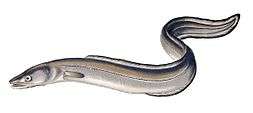
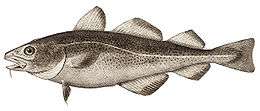
.png)
